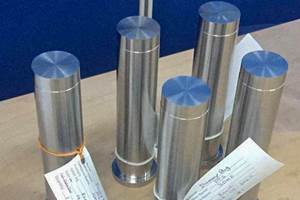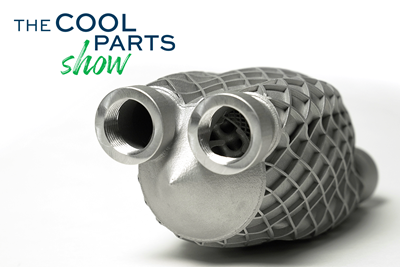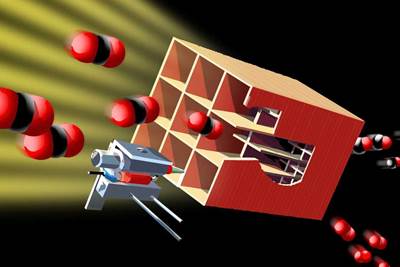Heat Exchangers 3D Printed from Haynes Alloy: The Cool Parts Show Bonus
Heat exchangers used in concentrated solar power must withstand elevated temperatures and pressures, and 3D printing enables the use of materials appropriate to this application.
Share
Scroll to unlock this premium content if video does not play.
While 3D printing is often applied to heat exchangers as a means of improving performance through geometry, there is another compelling reason to print these devices: material freedom. A project undertaken at Carnegie Mellon University sought to demonstrate the viability of additive manufacturing for producing heat exchangers used by the solar energy industry, which frequently operate at temperatures above 850ºC and pressures as high as 200 atmospheres. In this episode, we speak with Dr. Tony Rollett about demonstrator parts developed at CMU and produced through laser powder bed fusion from Haynes 230 and 282, two nickel-based alloys with creep resistance suitable to this application. | This episode of The Cool Parts Show is sponsored by Carpenter Additive
The Cool Parts Show is a video series from Additive Manufacturing Media that explores the what, how and why of unusual 3D printed parts. Watch more here.
Have a cool part to share? Email us.
Related Resources
- The Cool Parts Show episode featuring spacer grids for holding fuel rods used in nuclear power, also developed at Carnegie Mellon University
- A playlist of other videos about heat exchangers
- All of our heat exchanger stories
- More on additive manufacturing at Carnegie Mellon University
- A company that specializes in 3D printing of a different challenging metal: tungsten rhenium
Transcript
Pete Zelinski
I'm Pete.
Stephanie Hendrixson
I'm Stephanie, and this is a bonus episode of The Cool Parts Show our show all about interesting 3D printed parts. We recently shared an episode about these spacer grids for nuclear power that involved some work that was done at Carnegie Mellon University. In this bonus episode, we are going to look at some other research that is also happening at Carnegie Mellon with additive manufacturing.
But now for a totally different application.
Pete Zelinski
For heat exchangers. We have done episodes in the past on 3D printing for heat exchangers. We will put links in the show description.
As we're going to learn, these heat exchangers illustrate at least one other reason why additive manufacturing is a good solution.
Stephanie Hendrixson
That's right. In this case, it was a materials issue. And to understand why we had to talk a little bit more about the application. All of the heat exchangers that we have here and heat sinks were created as demonstrators for the solar industry. Specifically for concentrated solar power.
So dealing with lots and lots of energy and heat exchangers in this space commonly use what's called supercritical CO2.
They use that supercritical CO2 as an exchange mechanism to capture the energy and transfer it to a storage medium, usually something like molten salt.
In short, these heat exchangers are operating at extremely high pressures, very high temperatures. And that demands materials that we have not seen previously on The Cool Parts Show.
Pete Zelinski
So temperatures around 800°C or more. Pressures around 200 atmospheres. And that combination of heat and pressure means that creep is a potential failure mode for this hardware, and a very creep resistant metal is what's needed.
Stephanie Hendrixson
We learned about all this from Tony Rollett, who is the co-founder of CMU’s Next Manufacturing Center and a professor at the University.
Tony Rollett
The choice of material is quite challenging. The temperatures are on the order of 800 centigrade or higher. And the pressures are also very high. So it's not directly the pressure that matters, but it's the stress that you develop in the unit, which means that you have this pressure vessel and it’s therefore pressurized and therefore it's trying to expand.
And so what you have to do is to make it strong enough that it resists that, that expansion. And since you are at high temperature, which means that you're at a high fraction of the melting point of any metal that you might use, then it has to have good creep properties.
It means that when you go to temperatures as high as 800 centigrade, you have a very limited choice of materials that you can use.
Pete Zelinski
You said before it's a material we haven't covered on the show before. These parts are made out of Haynes Alloy. And maybe this is the only Haynes alloy cool part we will ever do.
So this is a heat sink. These are some smaller heat exchangers. These are made out of Haynes 230, which is nickel, chromium, tungsten, molybdenum, a lot going on.
This is a related material. This is Haynes alloy 282. This heat exchanger that's been cut apart. It has also been heat treated for greater strength. But the thing to understand is the same metal properties that allow it to endure this really aggressive application. Also, as a corollary, make this material really hard to work with in manufacturing and in particular make it really hard to cut in machining.
And so additive manufacturing provides a way to get the part close enough to minimize the amount of machining you need to do.
Stephanie Hendrixson
In this case, all of these heat exchangers were produced through laser powder bed fusion. They were made on an EOS M2 90 on the Carnegie Mellon campus. And using that powder bed technology allowed for building up each one of these heat exchangers, in just one piece.
And so getting very quickly to that near net shape that you were talking about. So this is making manufacturing easier in that sense, making it easier to work with a very challenging material. It also is bringing advantages in assembly consolidation as well. Compared to the way that heat exchangers are conventionally put together, being able to 3D print each one of these as a single piece has a lot of benefits
in terms of the durability of these parts. So in an application like this where creep is a concern, any place that metal has to be joined together becomes a potential weak point that could later fail.
Tony Rollett
And many radiators or heat exchangers are made by what we call brazing. So you put the pieces of metal together, typically sheet metal, you put something between them that will melt on a transient basis.
You take that assembly, you put it in an oven, take it to a specific temperature. The, the braze melts, it bonds the pieces of sheet metal together. And you have your heat exchanger.
Another way of doing it and what was the only way of fabricating these units a few years ago, was to make them like a layer cake.
So you would tape sheets or thin plates, you would cut or etch the channels that you wanted in each plate, and then you would stack up the plates so as to make the heat exchanger.
You take your stack, you take it to the oven, you apply pressure, put weights on it if you like, and you take it up to a high enough temperature that the pieces bond together, the atoms exchange places and make, make a bond.
And we call that diffusion bonding. And that was the standard way of trying to make these things.
Unfortunately, it is quite difficult to do the quality control so that you can guarantee that every place that needed to be bonded really is bonded.
And the other problem you have is that these are pressure vessels, they're under stress. They're under what we call a tensile stress or an opening stress.
So that means if there's anywhere where the bond didn't work, what you have is basically a narrow crack.
And a crack is a stress riser, a stress concentrator, and it's a place where it will start to fail. And so the experience with these was not good that they would commonly fail prematurely long before the intended life.
So that reminds me to say something about the lifetimes expected of these kinds of units, which is at least 10,000 hours, preferably even longer than that, if you can do it. And so that's why we ended up with 3D printing as the fabrication method of choice. So it's worth saying that, people often ask, well, why would you do 3D printing?
It's slow and it's expensive. And lucky for me, I have a very simple answer, which is, for these conditions of service, there's no other way to do it. As far as I know, 3D printing is the only way to make these these kinds of heat exchangers that will function and function for long times.
Stephanie Hendrixson
Even though design was not really the main driver behind this project, we should also say that there were, evolutions and advances in the design throughout the course of this work. So Carnegie Mellon actually collaborated with UC Davis on the geometry for these heat exchangers.
Tony Rollett
We collaborate with Professor Vinod Narayanan at the University of California, Davis, and he's the expert in the heat exchanger design.
And we consider ourselves the expert in 3D printing.
At the beginning we were very conservative about stresses in these devices at the use temperatures. And so that meant that we had to be, we had thicker walls than we really needed to.
As time goes by, what is happening is we're slowly reducing the wall thickness, because that very directly affects the heat exchange. We are reducing the wall thicknesses on the outside, sort of the pressure vessel aspect of it, essentially learning where the safety margin, where we're bumping into the safety margin for the design.
Stephanie Hendrixson
So these heat exchangers represent some of that early work to find those margins, to demonstrate to the solar energy community that 3D printing can be a viable technology for parts like this. And now they're working on other types of energy devices.
One example is solar receivers. So if you have a big field of solar mirrors that are all directing energy to one central collection point, you need a way to trap all of that energy. And that is what the receiver does. Again, often using that supercritical CO2 as an exchange medium.
A 3D printed solar receiver is actually going to be tested at Sandia National Labs very soon. Another example of something they're working on is called an oxiperator and this is for the natural gas industry.
Tony Rollett
Next stage is that we are going to print devices that we call oxiperators. It's a funny name for something that is designed to burn up residual methane. Think about natural gas, the supply of natural gas, the fact that there are pipelines running all over the country shipping natural gas. Every so often you have to have a compressor station.
Each compressor has to be driven by some kind of an engine. That engine is typically characteristically an internal combustion engine that runs off the natural gas in the pipeline.
Those engines are set to run as lean burn engines. That's done so as to minimize the emissions of nitrous oxide, but lean burn equates to not quite enough oxygen,
So there is a little bit of methane, a few percent say coming out of the engine in the exhaust stream. Methane is 28 times worse as a greenhouse gas than is CO2. We need to burn up that methane. But burning up methane at such small fractions, you can't just light a flame. There's just not enough methane to do it. So what we're doing is building hot boxes, oxiperators. We send the exhaust stream in at one end. We make sure it gets hot and stays hot.
The temperatures are the same temperatures we've been talking about, 800, 850 centigrade. We turn that gas around now that it's combusted but hot. And we do heat exchange in the same counter current designs that we've been looking at so as to warm up the input gas, get it hot enough to burn up and remove heat from the from the outlet gas.
And that's the next phase of this project is we're going to work with Prabhu Energy Labs in order to print and test these devices.
Pete Zelinski
If you are into 3D printed heat exchangers and you are, heat exchangers are really cool. We have done a whole playlist of videos on additive manufacturing for heat exchangers, a link to it in the show description.
Stephanie Hendrixson
And also check out our earlier episode about those spacer grids for nuclear energy, also featuring Carnegie Mellon. Again, we'll put a link in the description.
Related Content
BPMI Chooses Velo3D Metal 3D Printing System to Produce Parts for U.S. Naval Nuclear Propulsion Program
The fully integrated 3D printing solution will be operated by ATI in a newly established facility that will provide the U.S. Naval Nuclear Propulsion Program with alternatives to cast parts.
Read MoreConocoPhillips Sees Oil and Gas Supply Chain Opportunity With Additive Manufacturing
Production of parts when needed and where needed can respond to the oil and gas sector’s multibillion-dollar challenge of holding parts in inventory. The supply chain benefit will justify additive even before the design freedoms are explored.
Read MoreVideo: AM for Repair of Large Shafts
Wind power shafts that might once have been scrapped are now returned to service. See the robotic directed energy deposition (DED) and shaft preheating system developed by Ikergune, Izadi and Talens.
Read MoreResearchers Use Additive Manufacturing to Make Aircraft Propulsion Systems More Eco-Friendly
Project researchers aim to utilize hydrogen fuel cells and additive manufacturing as a pathway to achieve low-emission aviation by 2050. The goal is to recuperate the waste heat of a fuel cell-electric propulsion system, paving the way for a clearer, more sustainable future in aviation.
Read MoreRead Next
Spatter, Surrogate Modeling and More Advanced Manufacturing Research Happening at Carnegie Mellon University: AM Radio #53
In this trip report, we discuss research at the Manufacturing Futures Institute and Next Manufacturing Center, both under CMU’s umbrella, to advance industry with robotics, AI and additive manufacturing.
Read More3D Printed Heat Exchanger Uses Gyroids for Better Cooling | The Cool Parts Show #43
Replacement heat exchanger for a helicopter is half the size and delivers 4× the cooling, thanks to a geometry that could only be made via additive manufacturing.
Read More3D Printed Reactor Core Makes Solar Fuel Production More Efficient
The solar reactor uses water and CO2 from the air and sunlight as the energy source to produce carbon-neutral liquid fuels, for example, solar kerosene for aviation.
Read More
.jpg;width=70;height=70;mode=crop)














